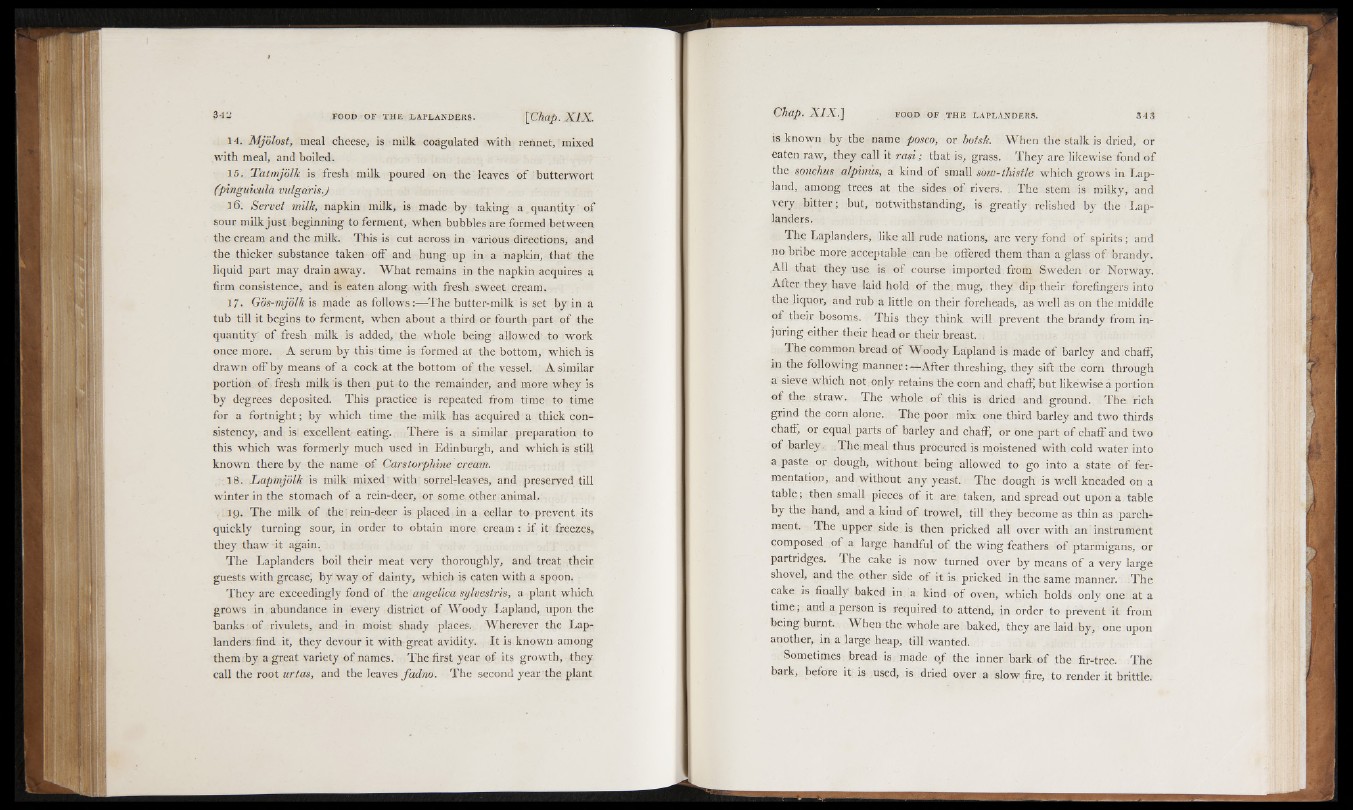
14. Mjolost, meal cheese, is milk coagulated with rennet, mixed
with meal, and boiled.
15 . Tatmjolk is fresh milk poured on the leaves of butterwort
(pinguicula vulgaris.J
16. Servet milk, napkin milk, is made by taking a quantity of
sour milkjust beginning to ferment, when bubbles are formed between
the cream and the milk. This is cut across in various directions, and
the thicker substance taken off and hung up in a napkin, that the
liquid part may drain away. What remains in the napkin acquires a
firm consistence, and is eaten along with fresh sWeet cream.
1 7 . Gos-mjolk is made as f o l l ows T h e butter-milk is set by in a
tub till it begins to ferment, when about a third or fourth part of the
quantity of fresh milk is added, the whole being allowed to work
once more. A serum by this time is formed:at the bottom, which is
drawn off by means of a cock at the bottom o f the vessel. ' A similar
portion of. fresh milk is then put to the remainder, and more whey is
by degrees deposited. This practice is repeated from time to time
for a fortnight; by which time the milk has acquired a thick consistency,
and is excellent eating. There is a similar preparation to
this which was formerly much used in Edinburgh, and which is still
known there by the name-of Carstorphine cream.
18. Lapmjolk is milk mixed'with sorrel-leaves, and preserved till
winter in the stomach of a rein-deer, or some, other animal.
. 1 9 . The milk of the: rein-deer is placed in a cellar to prevent its
quickly turning sour, in order to obtain more cream : if it freezes,
they thaw it again.
The Laplanders boil their meat very thoroughly, and treat their
guests with grease, by way o f dainty, Which is eaten with a spoon.
They are exceedingly fond of the angelica sylvestris, a plant which
grows in abundance in every district of Woody Lapland, upon the
hanks of rivulets, and in moist shady places. Wherever the Laplanders
find it, they devour it with great avidity. It is known among
them by a great variety of names. The first year of its growth, they
call the root urtas, and the leaves fadno. The second year the plant
is known by the name pnsco, or botsk. When the stalk is dried, or
eaten raw, they call it rasi; that is, grass. They are likewise fond of
the sonchus alpinus, a kind of small sow-thistle which grows in Lapland,
among trees at the sides o f rivers. The stem is miiky, and
very, bitter; but, notwithstanding, is greatly relished by the Laplanders.
The Laplanders, like all rude nations, are very fond o f spirits; and
no bribe more acceptable can be. offered them than a glass of brandy.
,A11 that they use is of course imported:from Sweden or Norway.
After they have laid hold o f the. mug, they dip their forefingers into
the liquor, and rub a little on their foreheads, as Well as on the.middle
of their bosoms. This they think will prevent the brandy from injuring
either their head or their breast. .
The common bread of Woody Lapland is made of barley and chaff,
in the following manner:—After threshing, they sift the corn through
a sieve which not only retains the corn and chaff but likewise a portion
o f the straw. The whole of this is dried and ground. The/rich
grind the corn alone, The poor mix one third barley and two thirds
chaff, or equal parts o f barley and chaff, or one part o f chaff and two
of barley,; The meal thus procured is moistened with cold water into
a paste or dough, without being allowed to go into a state of fermentation,
and without any yeast. The dough is well kneaded on a
table; then small pieces o f it are taken, and spread out upon a table
by the hand, and a kind of trowel, till they become as thin as parchment.
The .upper side is then pricked all over with an instrument
composed of a large handful o f the wing feathers of ptarmigans, or
partridges. The cake is now turned over by means o f a very large
shovel, and the other side of it is pricked in the same manner. The
cake is finally baked in a kind of oven, which holds only one at a
time; and a person is required to attend, in order to prevent it from
being burnt. When the whole are baked, they are laid by, one upon
another, in a large heap, till wanted.
Sometimes bread is made o,f the inner bark of the fir-tree. The
bark, before it is used, is dried oyer a slow fire, to render it brittle.